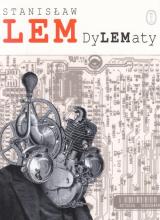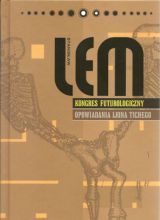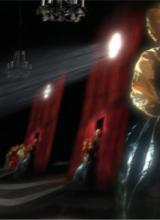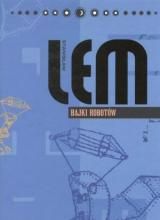 Stanisław Lem, “Pokój na Ziemi”
Stanisław Lem, “Pokój na Ziemi”
Janusz R. Kowalczyk

.
“Pokój na Ziemi” jest zarazem ostatnim tomem przygód Ijona Tichego, bohatera znanego z cyklu wcześniejszych opowiadań i powieści Lema: “Dzienniki gwiazdowe“, “Opowieści o pilocie Pirxie”, “Kongres futurologiczny“ czy “Wizja lokalna”. Tym razem komandor Tichy podjął się wyprawy na Księżyc w celu lepszej orientacji w panujących tam porządkach w poszczególnych sektorach militarnych. I choć jego skrajnie niebezpieczna misja była supertajna, to zarówno przed startem rakiety jak i po powrocie na Ziemię wielokrotnie nieomal cudem wymykał się z rąk zamachowców.
Misja została ściśle wypełniona, chociaż w wydobyciu z komandora cennych informacji jego mocodawcy napotkali na poważne trudności. Ich człowiek do zadań specjalnych przekroczył bowiem nieopatrznie na moment strefę bezpieczeństwa na Księżycu, co sprawiło, że w szczególny sposób został napromieniowany, przez co nabyta przezeń wiedza uległa rozwarstwieniu. Porażenie jednego z istotnych narządów mózgu wyrządziło nieodwracalne szkody – odtąd bowiem zapis lewej i prawej półkuli mózgowej nie łączyły się ze sobą, toteż ułomny raport z misji nie przedstawiał spodziewanej wartości.
“Każdy ma w głowie dwie półkule mózgu połączone wielkim spoidłem. Po łacinie corpus callosum. Dwieście milionów białych włókien nerwowych łączy mózg, żeby mógł zebrać myśli, ale już nie u mnie”, wyznał Tichy, który – jak w każdej z poprzednich opowieści z nim samym w roli głównej – w “Pokoju na Ziemi” jest również narratorem. Najtrudniejszy w jego stanie okazał się fakt, że jego organizm stwarzał mu poważne problemy w codziennym życiu, gdyż lewa strona ciała sabotowała wysiłki części prawej. Na przykład stronę maszynopisu pieczołowicie wystukaną prawą ręką, lewa dłoń natychmiast wyrywała z wałka maszyny do pisania i z pasją niszczyła, a niesforna noga, znajdująca się również po tejże stronie ciała, potrafiła kopnąć jego bezpośredniego zwierzchnika lub na przykład specjalistę naukowca, zajętego akurat badaniem kondycji astronauty.
W tym aspekcie powieściowej narracji można dopatrzeć się odwołań Stanisława Lema do jego medycznego wykształcenia, acz nie jest to jedyne odzwierciedlenie głębokiej i wielokierunkowej wiedzy, jaką pisarz przedstawił zarówno w “Pokoju na Ziemi”, jak i w pozostałych swoich dziełach. Geniusz autora obejmował szerokie spektrum drobiazgowo, wręcz na poziomie uniwersyteckim poznanych dziedzin nauki, poczynając od astronomii, przez matematykę, fizykę, chemię, biologię, geologię, antropologię, historię, aż do filozofii, religioznawstwa etc., etc. Przejawia się to mimowiednie, jak choćby w przypadku niezobowiązującej rozmowy naziemnych dysponentów pilota z nim samym, kiedy to się okazało, że fotel na którym siedział, “był naszpikowany czujnikami, aby podług mikroskopijnych zmian napięcia mięśni badać jego reakcję na słowa zwane kluczowymi bodźcami” – jednym słowem, ostrożność (nieufność?) przełożonych w każdym calu.
Chodziło o to, żeby żadne państwo z osobna ani żadna grupa lub może potajemna koalicja państw nie mogła poznać rezultatów księżycowego zwiadu, jeśli się uda, bo ten, kto by poznał jako pierwszy tameczny stan zbrojeń, mógł uzyskać tym samym strategiczną informację, dającą mu nagłą przewagę na Ziemi. Panujący na niej pokój nie był wcale, jak z tego widać, idyllą.
Tak zatem, zanim dobrotliwi uczeni wypuścili Ijona w przestrzeń kosmiczną, przeprowadzali na żywo sekcję jego mózgu. Działo się to, oczywiście, jeszcze przed jego misją, natomiast po powrocie pilota przyjęli inną taktykę: ponieważ mózg komandora Tichego nadal zachowywał ważne dla obronności informacje, choć on sam z siebie nie umiał ich wyartykułować, trzeba było ich strzec jak oka w głowie, żeby on sam – lub też tylko zawartość jego czaszki – nie trafiły w niepowołane ręce armii wszechobecnych agentów wrogich wywiadów.
Stanisław Lem nie byłby sobą, gdyby wśród pochwały najnowszych zdobyczy technologii nie dopatrzył się tej lub innej wadliwości wprowadzanych udoskonaleń. Od czasu bowiem, kiedy komputery w postępie wykładniczym przerosły pojemność i możliwości umysłów ludzkich, najczęściej zawodziła ich obsługa, czyli człowiek. Niekiedy było to zwyczajne niedbalstwo, skutkujące jednak nader przykrymi konsekwencjami.
Wystarczyło, żeby do kokonu rozmaitych kabli i urządzeń, w który owinięty był Ijon, dodatkowo wciśnięty w kosmiczny skafander, dostał się niepostrzeżenie upuszczony wycior do fajki jednego z techników naziemnej ekipy, co sprawiało, że pilot nie mógł postąpić kroku naprzód bez uczucia nasilającego się mrowienia nogi, a to oczywiście mogło zaważyć na powodzeniu planowanego zamierzenia. Na szczęście komandor potraktował ów epizod z wrodzonym sobie, przewrotnym poczuciem humoru: “To ja wykryłem Prawo Tichego, powiadające, że jako pierwsza zaczyna świerzbić i łaskotać ta cześć ciała, w którą żadnym sposobem nie można się podrapać”.
Fantastyka naukowa nie narodziła się w Polsce wraz z podbojem kosmosu. Futurologiczne wizje zapisywano, gdy polskie miasta dopiero nieśmiało wkraczały w nowoczesność. Poznaj trzech pisarzy, którzy ukształtowali Lema za młodu.
Jak zawsze u Lema, tak i “Pokój na Ziemi” zapowiada technologie przyszłości, które wkrótce (oby nie!) mogą się stać rzeczywistością. Pisarza nie opuszcza jednak sceptycyzm, co do metod ich zastosowania, skoro z rozmaitych mniej lub bardziej wytłumaczalnych powodów najprężniej korzysta z nich przemysł militarny. Postępu nauki nie sposób jednak zatrzymać, toteż trudno nie liczyć się z daleko idącą miniaturyzacją uzbrojenia.
Już nie atom, nie wodór, ani siła coraz potężniejszych dział i rakiet mniej lub bardziej dalekiego zasięgu zaczyna odgrywać znaczącą rolę w walkach przeciwstawnych sobie państw czy sojuszy militarnych. Wzorując się na szybko odradzających się populacjach owadów, wychodzących prawie bez uszczerbku z rozmaitych klęsk klimatycznych czy żywiołowych, inżynieria militarna przerzuciła się na produkcję trudnych do wyśledzenia i zatrzymania chmur miliardów mikropów, jak Stanisław Lem nazwał przemieszczające się mikroautomaty, zdolne do przeciskania się przez najdrobniejsze szczeliny, żeby potem połączyć się w cokolwiek je zaprojektowano, na przykład w centaura, jak w powieści, czy też w bardziej skomplikowaną machinę niosącą śmierć i spustoszenie. Ten stan rzeczy przestaje być zresztą powieściową fikcją, a powoli, niemal na naszych oczach, staje się rzeczywistością – zawsze gdy w grę wchodzą “wyższe” względy polityczne, ekonomiczne czy militarne – i wcale nie są to gwiezdne wojny, lecz czysto ziemskie, te czy inne podjazdowe “wojny hybrydowe”.
W “Pokoju na Ziemi” autor nawiązuje do swoich wcześniejszych powieści, na przykład w “Niezwyciężonym” chmura mikroautomatów niszczyła zawartość mózgów wszelkich żywych istot. Z kolei w “Pamiętniku znalezionym w wannie” zjadliwa bakteria rozkładała papier, a zatem wszystko, co było na nim zapisane. Jeszcze innym wynalazkiem jest wspomniany w “Pokoju na Ziemi” tak zwany zdalnik, czyli naszpikowany elektroniką automat, perfekcyjnie wykonujący w zastępstwie człowieka, i z bezpiecznego oddalenia, czynności, których on sam wolałby uniknąć (dysponujemy już na przykład zdalnym urządzeniem do rozbrajania ładunków wybuchowych).
Pomijając jednak czysto techniczne rozwiązania spraw związanych z misjami kosmicznymi, nie można zapomnieć, że powieść Lema dostarcza nie tylko sporej dawki emocji spod znaku awanturniczo-przygodowej sensacji, ale także istotnych przemyśleń natury stricte etycznej. Nabyta w podróży na księżycowy poligon ułomność komandora Ijona Tichego sprawiła, że został uznany jako ktoś (coś?) na kształt twardego dysku, na którym znajdują się cenne informacje, lecz na razie nikt nie dobrał do nich właściwego klucza czy kodu dostępu. Przypuszczalnie tylko dlatego bohater powieści nie został unieszkodliwiony przez wrogie siły, wliczając w to, niestety, jego własnych mocodawców.
Gdyby swoją misję zakończył złożeniem pełnego raportu, to jako człowiek nadal posiadający równie bezcenną wiedzę, nie mógłby się swobodnie poruszać po naszej planecie. Szczęściem w nieszczęściu jego zwierzchności nie udało się go w pełni wyzyskać, co go uratowało przed niechybnym unicestwieniem. Nie ma chyba większej niesprawiedliwości na tym najlepszym ze światów, gdy za dobrze wykonane obowiązki zapłatą jest śmierć z rąk dawnych protektorów.
Uciekający przed wrogami jak i przed pryncypałami Ijon Tichy systematycznie dochodził istoty rzeczy, na ile pozwalał mu jego obecny stan kallotomii. Wielopiętrowo nawarstwiona maskarada pozorów czy gra gier, w jaką został uwikłany, swoim zaplątaniem przerastała wszystkie dotąd przeżyte przezeń perypetie. Rzecz w tym jednak, że znacznie większym zagrożeniem były dla niego nie podboje przestrzeni kosmicznej, lecz próba ułożenia sobie w miarę spokojnego życia na Ziemi, co – póki czas – powinno dać nam to i owo do myślenia.
-
Stanisław Lem
“Pokój na Ziemi”
Wydawnictwo Literackie, Kraków 2021
posłowie: Jerzy Jarzębski
format: 123 x 197 mm
oprawa: miękka ze skrzydełkami
liczba stron: 376
ISBN: 978-83-08-06191-6
Pozostałe dzieła Stanisław Lem
Zawartość publikowanych artykułów i materiałów nie reprezentuje poglądów ani opinii Reunion’68,
ani też webmastera Blogu Reunion’68, chyba ze jest to wyraźnie zaznaczone.
Twoje uwagi, linki, własne artykuły lub wiadomości prześlij na adres:
webmaster@reunion68.com















